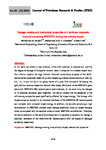Damage sensing and mechanical properties of a laminate composite material containing MWCNTs during low-velocity impact
| dc.contributor.author | Al-Bahrani, M | |
| dc.contributor.author | Alhakeem, MRH | |
| dc.contributor.author | Cree, Alistair | |
| dc.date.accessioned | 2022-03-04T10:43:21Z | |
| dc.date.available | 2022-03-04T10:43:21Z | |
| dc.date.issued | 2020-12-21 | |
| dc.identifier.issn | 2220-5381 | |
| dc.identifier.issn | 2710-1096 | |
| dc.identifier.uri | http://hdl.handle.net/10026.1/18885 | |
| dc.description.abstract |
<jats:p>In this work, we present a new criterion, unlike other attempts, to evaluate and quantify the degree of damage of composite material when it subjected to a sudden impact load. Our criterion exploits the high intrinsic electrical conductivity property of the Multi-walled carbon nanotubes (MWCNTs) after dispersing different concentrations of them (0, 0.5, 1.0, 1.5 and 2.0 %) in the epoxy matrix of a glass fibre composite. Following this goal, the low-velocity impact and flexural after impact (FAI) tests on the MWCNTs-glass epoxy (i.e. MWCNTs-GF) nanocomposite were evaluated. At the same time, the changes in its electrical resistance were measured. The results showed that the properties of the self-sensing composites were significantly affected by impact energy. The damage after impact causes an increase in the electrical resistance of the MWCNTs-GF nanocomposite and increases with increased impact energy. In addition, the samples containing a high concentration of MWCNTs showed lower damage sensitivity under all impact energies levels as compared with the samples contain a lower MWCNTs concentration. Therefore, the results presented in this work have shown that it is possible to associate the change in electrical resistance of the MWCNTs-GF nanocomposite with the degree of damages caused by impact load.</jats:p> | |
| dc.format.extent | 147-164 | |
| dc.language.iso | en | |
| dc.publisher | Petroleum Research and Development Center (PRDC) | |
| dc.subject | 7 Affordable and Clean Energy | |
| dc.title | Damage sensing and mechanical properties of a laminate composite material containing MWCNTs during low-velocity impact | |
| dc.type | journal-article | |
| plymouth.issue | 4 | |
| plymouth.volume | 10 | |
| plymouth.publication-status | Published online | |
| plymouth.journal | Journal of Petroleum Research and Studies | |
| dc.identifier.doi | 10.52716/jprs.v10i4.375 | |
| plymouth.organisational-group | /Plymouth | |
| plymouth.organisational-group | /Plymouth/Faculty of Science and Engineering | |
| plymouth.organisational-group | /Plymouth/Faculty of Science and Engineering/School of Engineering, Computing and Mathematics | |
| plymouth.organisational-group | /Plymouth/REF 2021 Researchers by UoA | |
| plymouth.organisational-group | /Plymouth/REF 2021 Researchers by UoA/UoA12 Engineering | |
| plymouth.organisational-group | /Plymouth/Users by role | |
| plymouth.organisational-group | /Plymouth/Users by role/Academics | |
| dcterms.dateAccepted | 2020-12-21 | |
| dc.rights.embargodate | 2022-3-8 | |
| dc.identifier.eissn | 2710-1096 | |
| dc.rights.embargoperiod | Not known | |
| rioxxterms.versionofrecord | 10.52716/jprs.v10i4.375 | |
| rioxxterms.licenseref.uri | http://www.rioxx.net/licenses/all-rights-reserved | |
| rioxxterms.type | Journal Article/Review |


